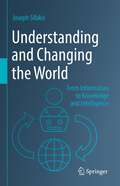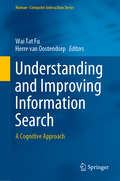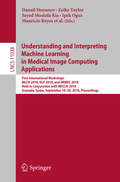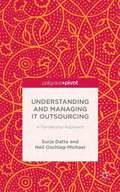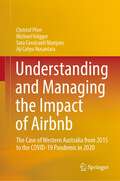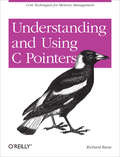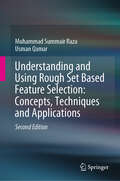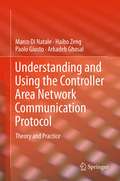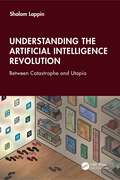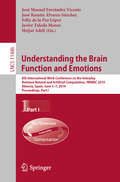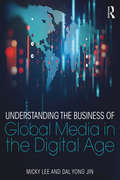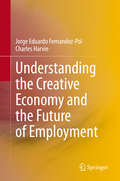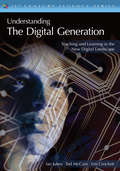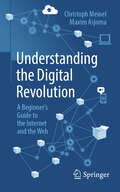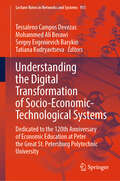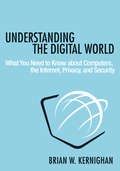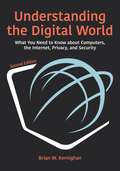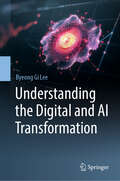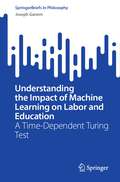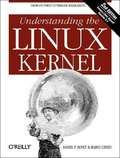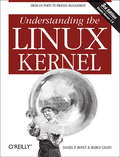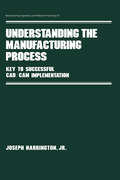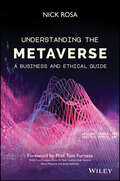- Table View
- List View
Understanding and Changing the World: From Information to Knowledge and Intelligence
by Joseph SifakisThis book discusses the importance of knowledge as an intangible asset, separate from physical entities, that can enable us to understand and/or change the world. It provides a thorough treatment of knowledge, one that is free of ideological and philosophical preconceptions, and which relies exclusively on concepts and principles from the theory of computing and logic. It starts with an introduction to knowledge as truthful and useful information, and its development and management by computers and humans. It analyses the relationship between computational processes and physical phenomena, as well as the processes of knowledge production and application by humans and computers. In turn, the book presents autonomous systems that are called upon to replace humans in complex operations as a step toward strong AI, and discusses the risks – real or hypothetical – of the careless use of these systems. It compares human and machine intelligence, attempting to answer the question of whether and to what extent computers, as they stand today, can approach human-level situation awareness and decision-making. Lastly, the book explains the functioning of individual consciousness as an autonomous system that manages short- and long-term objectives on the basis of value criteria and accumulated knowledge. It discusses how individual values are shaped in society and the role of institutions in fostering and maintaining a common set of values for strengthening social cohesion. The book differs from books on the philosophy of science in many respects, e.g. by considering knowledge in its multiple facets and degrees of validity and truthfulness. It follows the dualist tradition of logicians, emphasizing the importance of logic and language and considering an abstract concept of information very different from the one used in the physical sciences. From this perspective, it levels some hopefully well-founded criticism at approaches that consider information and knowledge as nothing more than the emergent properties of physical phenomena. The book strikes a balance between popular books that sidestep fundamental issues and focus on sensationalism, and scientific or philosophical books that are not accessible to non-experts. As such, it is intended for a broad audience interested in the role of knowledge as a driver for change and development, and as a common good whose production and application could shape the future of humanity.
Understanding and Improving Information Search: A Cognitive Approach (Human–Computer Interaction Series)
by Herre Van Oostendorp Wai Tat FuThis edited book adopts a cognitive perspective to provide breadth and depth to state-of-the-art research related to understanding, analyzing, predicting and improving one of the most prominent and important classes of behavior of modern humans, information search. It is timely as the broader research area of cognitive computing and cognitive technology have recently attracted much attention, and there has been a surge in interest to develop systems and technology that are more compatible with human cognitive abilities. Divided into three interlocking sections, the first introduces the foundational concepts of information search from a cognitive computing perspective to highlight the research questions and approaches that are shared among the contributing authors. Relevant concepts from psychology, information and computing sciences are addressed. The second section discusses methods and tools that are used to understand and predict information search behavior and how the cognitive perspective can provide unique insights into the complexities of the behavior in various contexts. The final part highlights a number of areas of applications of which education and training, collaboration and conversational search interfaces are important ones. Understanding and Improving Information Search - A Cognitive Approach includes contributions from cognitive psychologists, information and computing scientists around the globe, including researchers from Europe (France, Netherlands, Germany), the US, and Asia (India, Japan), providing their unique but coherent perspectives to the core issues and questions most relevant to our current understanding of information search behavior and improving information search.
Understanding and Interpreting Machine Learning in Medical Image Computing Applications: First International Workshops, Mlcn 2018, Dlf 2018, And Imimic 2018, Held In Conjunction With Miccai 2018, Granada, Spain, September 16-20, 2018, Proceedings (Lecture Notes in Computer Science #11038)
by Sergio Pereira Mauricio Reyes M. Jorge Cardoso Ipek Oguz Lena Maier-Hein Danail Stoyanov Zeike Taylor Anne Martel Seyed Mostafa Kia Andre F. Marquand Edouard Duchesnay Tommy Löfstedt Bennett Landman Carlos A. Silva Raphael MeierThis book constitutes the refereed joint proceedings of the First International Workshop on Machine Learning in Clinical Neuroimaging, MLCN 2018, the First International Workshop on Deep Learning Fails, DLF 2018, and the First International Workshop on Interpretability of Machine Intelligence in Medical Image Computing, iMIMIC 2018, held in conjunction with the 21st International Conference on Medical Imaging and Computer-Assisted Intervention, MICCAI 2018, in Granada, Spain, in September 2018. The 4 full MLCN papers, the 6 full DLF papers, and the 6 full iMIMIC papers included in this volume were carefully reviewed and selected. The MLCN contributions develop state-of-the-art machine learning methods such as spatio-temporal Gaussian process analysis, stochastic variational inference, and deep learning for applications in Alzheimer's disease diagnosis and multi-site neuroimaging data analysis; the DLF papers evaluate the strengths and weaknesses of DL and identify the main challenges in the current state of the art and future directions; the iMIMIC papers cover a large range of topics in the field of interpretability of machine learning in the context of medical image analysis.
Understanding and Managing IT Outsourcing: A Partnership Approach
by Surja Datta Neil Oschlag-MichaelThis book explains and illustrates how uncertainty and trust interact with each other, and how an understanding of this interaction is critical to success in IT outsourcing. A partnership approach that is built on trust can determine success but this book explains in which particular outsourcing context this approach is likely to pay dividends.
Understanding and Managing the Impact of Airbnb: The Case of Western Australia from 2015 to the COVID-19 Pandemic in 2020
by Michael Volgger Christof Pforr Sara Cavalcanti Marques Aji Cahya NusantaraThis book explores the rapid growth of the sharing economy, specifically of Airbnb, in recent years and how it has challenged traditional economies in many countries around the globe. With almost 5 million listings in more than 190 countries, many consider Airbnb as one of the most disruptive developments in tourism over the past decade. While this is a book about Western Australia as a case in point, the issues addressed in this book speak to the broader development of the sharing economy and its effects experienced nationally and indeed internationally. Thus, through the adoption of a case-specific analysis of the growth and impact of Airbnb, the book significantly contributes to closing existing knowledge gaps on the Airbnb phenomenon by exploring not only stakeholder perceptions of the sharing economy and Airbnb, the extent of Airbnb supply and demand, and how this differs from conventional accommodation demand, but also what policy responses have been employed in other tourism destinations worldwide. Western Australia in this regard serves as an exemplar case to shed light on the Airbnb phenomenon. This book presents a comprehensive global study that has investigated the Airbnb phenomenon from a supply, demand, stakeholder, and government response perspective and thus offers new empirical insights, which are of interest to government agencies and the tourism sector and are a valuable source of data to inform current policy debate.
Understanding and Using C Pointers: Core Techniques for Memory Management
by Richard M ReeseImprove your programming through a solid understanding of C pointers and memory management. With this practical book, you’ll learn how pointers provide the mechanism to dynamically manipulate memory, enhance support for data structures, and enable access to hardware. Author Richard Reese shows you how to use pointers with arrays, strings, structures, and functions, using memory models throughout the book.Difficult to master, pointers provide C with much flexibility and power—yet few resources are dedicated to this data type. This comprehensive book has the information you need, whether you’re a beginner or an experienced C or C++ programmer or developer.Get an introduction to pointers, including the declaration of different pointer typesLearn about dynamic memory allocation, de-allocation, and alternative memory management techniquesUse techniques for passing or returning data to and from functionsUnderstand the fundamental aspects of arrays as they relate to pointersExplore the basics of strings and how pointers are used to support themExamine why pointers can be the source of security problems, such as buffer overflowLearn several pointer techniques, such as the use of opaque pointers, bounded pointers and, the restrict keyword
Understanding and Using Rough Set Based Feature Selection: Concepts, Techniques and Applications
by Muhammad Summair Raza Usman QamarThis book provides a comprehensive introduction to rough set-based feature selection. Rough set theory, first proposed by Zdzislaw Pawlak in 1982, continues to evolve. Concerned with the classification and analysis of imprecise or uncertain information and knowledge, it has become a prominent tool for data analysis, and enables the reader to systematically study all topics in rough set theory (RST) including preliminaries, advanced concepts, and feature selection using RST. The book is supplemented with an RST-based API library that can be used to implement several RST concepts and RST-based feature selection algorithms.The book provides an essential reference guide for students, researchers, and developers working in the areas of feature selection, knowledge discovery, and reasoning with uncertainty, especially those who are working in RST and granular computing. The primary audience of this book is the research community using rough set theory (RST) to perform feature selection (FS) on large-scale datasets in various domains. However, any community interested in feature selection such as medical, banking, and finance can also benefit from the book. This second edition also covers the dominance-based rough set approach and fuzzy rough sets. The dominance-based rough set approach (DRSA) is an extension of the conventional rough set approach and supports the preference order using the dominance principle. In turn, fuzzy rough sets are fuzzy generalizations of rough sets. An API library for the DRSA is also provided with the second edition of the book.
Understanding and Using the Controller Area Network Communication Protocol
by Paolo Giusto Arkadeb Ghosal Haibo Zeng Marco Di NataleThis book to offers a hands-on guide to designing, analyzing and debugging a communication infrastructure based on the Controller Area Network (CAN) bus. Although the CAN bus standard is well established and currently used in most automotive systems, as well as avionics, medical systems and other devices, its features are not fully understood by most developers, who tend to misuse the network. This results in lost opportunities for better efficiency and performance. These authors offer a comprehensive range of architectural solutions and domains of analysis. It also provides formal models and analytical results, with thorough discussion of their applicability, so that it serves as an invaluable reference for researchers and students, as well as practicing engineers.
Understanding the Art of Sound Organization
by Leigh LandyThe first work to propose a comprehensive musicological framework to study sound-based music, a rapidly developing body of work that includes electro-acoustic art music, turntable composition, and acoustic and digital sound installations.
Understanding the Artificial Intelligence Revolution: Between Catastrophe and Utopia
by Shalom LappinAfter many years during which it languished in relative obscurity, in remote classrooms of computer science departments and in small prototype projects for tech companies, artificial intelligence (AI) is now a searingly hot topic across the media. Yet much of the public discussion is so feverish that an understanding of the basic scientific and engineering elements of the field is easily lost, often resulting in exaggerated claims, as well as dangerously neglected threats.This concise and sober book presents a brief history of AI, explaining in clear language the central engineering innovations that have produced the current revolution. It distinguishes between imagined dangers and the very real problems that AI is creating. Spread across seven short and accessible chapters, this book explains the developments behind deep learning and the applications of deep neural networks (DNNs). It addresses both the imagined and actual risks posed by the AI revolution, before outlining the elements of a rational public policy on AI, covering topics like tech monopolies, disinformation, bias, hate speech, intellectual property rights, and inequality.Suitable for the general reader, Understanding the Artificial Intelligence Revolution: Between Catastrophe and Utopia is the ideal book for anyone seeking a clear and informed introduction to AI.
Understanding the Brain Function and Emotions: 8th International Work-Conference on the Interplay Between Natural and Artificial Computation, IWINAC 2019, Almería, Spain, June 3–7, 2019, Proceedings, Part I (Lecture Notes in Computer Science #11486)
by Hojjat Adeli José Manuel Ferrández Vicente José Ramón Álvarez-Sánchez Félix de la Paz López Javier Toledo MoreoThe two volume set LNCS 11486 and 11487 constitutes the proceedings of the International Work-Conference on the Interplay Between Natural and Artificial Computation, IWINAC 2019, held in Almería, Spain,, in June 2019. The total of 103 contributions was carefully reviewed and selected from 190 submissions during two rounds of reviewing and improvement. The papers are organized in two volumes, one on understanding the brain function and emotions, addressing topics such as new tools for analyzing neural data, or detection emotional states, or interfacing with physical systems. The second volume deals with bioinspired systems and biomedical applications to machine learning and contains papers related bioinspired programming strategies and all the contributions oriented to the computational solutions to engineering problems in different applications domains, as biomedical systems, or big data solutions.
Understanding the Business of Global Media in the Digital Age
by Dal Yong Jin Micky LeeThis new introductory textbook provides students with the tools they need to understand the way digital technologies have transformed the global media business of the 21st century. Focusing on three main approaches – media economics, critical political economy, and production studies – the authors provide an empirically rich analysis of ownership, organizational structures and culture, business strategies, markets, networks of strategic alliances, and state policies as they relate to global media. Examples throughout involve both traditional and digital media and are taken from different regions and countries to illustrate how the media business is influenced by interconnected historical, political, economic, and social factors. In addition to introducing today’s convergent world of global media, the book gives readers a greater understanding of their own potential roles within the global media industries.
Understanding the Creative Economy and the Future of Employment
by Charles Harvie Jorge Eduardo Fernandez-PolThe motivation of this book is simple, yet fundamental: No complete understanding of the modern economy is possible without a thorough grounding in the field of innovation as an economic activity.The book, as its title emphasizes, aims at helping readers to gain a comprehension of two inextricably linked issues: challenging innovation and the future of human work. To this end, the book integrates a triad of topics: innovation as an economic activity, modus operandi of an innovation-driven economy, and the persistent progression toward automation of human jobs.The main message conveyed by this book is that a creative economy will converge to an economy governed by smart machines aka robots, but will produce benefits if addressed in a rational manner.As to the salient features of this book, Accessibility: Accessible to readers with only cursory knowledge (if any) in economicsStyle: Adherence to a discursive, non-mathematical styleBrevity: Covers material in a succinct, easily understandable manner, drawing upon real world examplesAppendices: Each chapter is supplemented with appendices that elaborate upon pertinent real world examples and applicationsSelf-contained: All the key concepts are defined and exemplified within the bookApplicability: Uses examples that resonate with a wide audience of readers concerned about the advance of robotsNon-mathematical diagrams: Provides accessible and readily understandable figures/graphsProtective stance: Contains a rational response to the march of the robots which is useful for workers of all ages
Understanding the Digital Generation: Teaching and Learning in the New Digital Landscape
by Ian Jukes Lee Crockett Ted McCainAn innovative look at reshaping the educational experiences of 21st-century learners! Inspiring thoughtful discussion that leads to change, this reader-friendly resource examines how the new digital landscape is transforming teaching and learning in an environment of standards, accountability, and high-stakes testing and why informed leadership is so critical. The authors present powerful strategies and compelling viewpoints, underscore the necessity of developing relevant classroom experiences, and discuss: Attributes common among digital learners; The concepts of neuroplasticity and the hyperlinked mind; An educational approach that supports traditional literacy skills alongside 21st-century fluencies; Evaluation methods that encompass how digital generation students process new information.
Understanding the Digital Revolution: A Beginner's Guide to the Internet and the Web
by Christoph Meinel Maxim AsjomaHow does the most important technology of our time - the Internet and WWW – work? The authors explain in simple language and in short the individual technical building blocks and organizational structures, behind the greatest innovation of our time. Only those who know how the technologies that determine our everyday lives can deal with them confidently and in souvereignity. Although digitalization is shaping our daily lives, the technologies behind the Internet and WWW remain obscure to most people. This book provides the key to understanding the huge developments of our time.
Understanding the Digital Transformation of Socio-Economic-Technological Systems: Dedicated to the 120th Anniversary of Economic Education at Peter the Great St. Petersburg Polytechnic University (Lecture Notes in Networks and Systems #951)
by Tatiana Kudryavtseva Mohammed Ali Berawi Tessaleno Campos Devezas Sergey Evgenievich BarykinThis book is dedicated to the 120th anniversary of economic education at Peter the Great St. Petersburg Polytechnic University (SPbPU). It gathers the best and most recent research materials of scientists from SPbPU’s Institute of Industrial Management, Economics and Trade and their colleagues from other universities.This book reflects many years of experience, unique results and interesting discoveries made by collaborative teams exploring the following issues: engineering economics, sustainable development and other topics related to the digitalization of enterprises, industries and systems; digital transformation of the service market in the face of global challenges; automation of enterprise control systems, digital and data management solutions for business; socio-economic development and territorial management in the era of Industry 4.0, etc. This book offers various views on challenges faced by today's economy and industry that are undoubtedly relevant to readers of almost all categories: from students to practitioners and scientists, but mostly for researchers.
Understanding the Digital World: What You Need to Know about Computers, the Internet, Privacy, and Security
by Brian W. KernighanComputers are everywhere. Some of them are highly visible, in laptops, tablets, cell phones, and smart watches. But most are invisible, like those in appliances, cars, medical equipment, transportation systems, power grids, and weapons. We never see the myriad computers that quietly collect, share, and sometimes leak vast amounts of personal data about us. Through computers, governments and companies increasingly monitor what we do. Social networks and advertisers know far more about us than we should be comfortable with, using information we freely give them. Criminals have all-too-easy access to our data. Do we truly understand the power of computers in our world?Understanding the Digital World explains how computer hardware, software, networks, and systems work. Topics include how computers are built and how they compute; what programming is and why it is difficult; how the Internet and the web operate; and how all of these affect our security, privacy, property, and other important social, political, and economic issues. This book also touches on fundamental ideas from computer science and some of the inherent limitations of computers. It includes numerous color illustrations, notes on sources for further exploration, and a glossary to explain technical terms and buzzwords.Understanding the Digital World is a must-read for all who want to know more about computers and communications. It explains, precisely and carefully, not only how they operate but also how they influence our daily lives, in terms anyone can understand, no matter what their experience and knowledge of technology.
Understanding the Digital World: What You Need to Know about Computers, the Internet, Privacy, and Security, Second Edition
by Brian W. KernighanA brand-new edition of the popular introductory textbook that explores how computer hardware, software, and networks workComputers are everywhere. Some are highly visible, in laptops, tablets, cell phones, and smart watches. But most are invisible, like those in appliances, cars, medical equipment, transportation systems, power grids, and weapons. We never see the myriad computers that quietly collect, share, and sometimes leak personal data about us. Governments and companies increasingly use computers to monitor what we do. Social networks and advertisers know more about us than we should be comfortable with. Criminals have all-too-easy access to our data. Do we truly understand the power of computers in our world?In this updated edition of Understanding the Digital World, Brian Kernighan explains how computer hardware, software, and networks work. Topics include how computers are built and how they compute; what programming is; how the Internet and web operate; and how all of these affect security, privacy, property, and other important social, political, and economic issues. Kernighan touches on fundamental ideas from computer science and some of the inherent limitations of computers, and new sections in the book explore Python programming, big data, machine learning, and much more. Numerous color illustrations, notes on sources for further exploration, and a glossary explaining technical terms and buzzwords are included.Understanding the Digital World is a must-read for readers of all backgrounds who want to know more about computers and communications.
Understanding the Digital and AI Transformation
by Byeong Gi LeeThis book offers a comprehensive and in-depth exploration of key digital and AI technologies, providing readers with a thorough understanding of the concepts and advancements driving the digital and AI transformation. Readers will gain the foundational knowledge needed to engage and keep abreast with the subject matter effectively. The chapters are organized in a systematic and logical way, starting from foundation (ICT), technologies (digital platforms, digital technologies, AI technology), and applications in industry and in society. The book addresses the critical ethical and societal issues surrounding digital and AI technologies, discusses regulatory frameworks, and explores potential solutions to these challenges. This feature is especially valuable for policymakers and general readers who need to understand the broader implications of technological advancements and make informed decisions accordingly. By including the businesses and issues of the leading platform companies like Apple, Google, Amazon, and Meta, and also by including the case studies of successful digital transformations in various industries like ENGIE, John Deere, POSCO, and Hyundai Motors, the book provides practical insights and actionable strategies. This feature is particularly valuable for professionals and academics who can learn from real-world applications and apply these lessons to their own contexts. Although the content is most relevant to professionals in the technology, business, and industry sectors who are involved in digital and AI transformation initiatives, the book is designed to be accessible to readers at any level, especially to those who want to keep abreast with the advancement of digital and AI technologies.
Understanding the Impact of Machine Learning on Labor and Education: A Time-Dependent Turing Test (SpringerBriefs in Philosophy)
by Joseph GanemThis book provides a novel framework for understanding and revising labor markets and education policies in an era of machine learning. It posits that while learning and knowing both require thinking, learning is fundamentally different than knowing because it results in cognitive processes that change over time. Learning, in contrast to knowing, requires time and agency. Therefore, “learning algorithms”—that enable machines to modify their actions based on real-world experiences—are a fundamentally new form of artificial intelligence that have potential to be even more disruptive to labor markets than prior introductions of digital technology. To explore the difference between knowing and learning, Turing’s “Imitation Game,”—that he proposed as a test for machine thinking—is expanded to include time dependence. The arguments presented in the book introduce three novel concepts: (1) Comparative learning advantage: This is a concept analogous to comparative labor advantage but arises from the disparate times required to learn new knowledge bases/skillsets. It is argued that in the future, comparative learning advantages between humans and machines will determine their division of labor. (2) Two dimensions of job performance—expertise and interpersonal: Job tasks can be sorted into two broad categories. Tasks that require expertise have stable endpoints, which makes these tasks inherently repetitive and subject to automation. Tasks that are interpersonal are highly context-dependent and lack stable endpoints, which makes these tasks inherently non-routine. Humans compared to machines have a comparative learning advantage along the interpersonal dimension, which is increasing in value economically. (3) The Learning Game is a time-dependent version of Turing’s “Imitation Game.” It is more than a thought experiment. The “Learning Game” provides a mathematical framework with quantitative criteria for training and assessing comparative learning advantages. The book is highly interdisciplinary—presenting philosophical arguments in economics, artificial intelligence, and education. It also provides data, mathematical analysis, and testable criteria that researchers in these fields will find of practical use. The book calls for a rethinking of how labor markets operate and how the education system should prepare students for future jobs. It concludes with a list of counterintuitive recommendations for future education and labor policies that all stakeholders—employers, employees, educators, students, and political leaders—should heed.
Understanding the Linux Kernel, 2nd Edition
by Daniel P. Bovet Marco CesatiThe new edition of Understanding the Linux Kernel takes you on a guided tour through the most significant data structures, many algorithms, and programming tricks used in the kernel. The book has been updated to cover version 2.4 of the kernel, which is quite different from version 2.2: the virtual memory system is entirely new, support for multiprocessor systems is improved, and whole new classes of hardware devices have been added. You'll learn what conditions bring out Linux's best performance, and how it meets the challenge of providing good system response during process scheduling, file access, and memory management in a wide variety of environments.
Understanding the Linux Kernel, 3rd Edition
by Daniel P. Bovet Marco CesatiIn order to thoroughly understand what makes Linux tick and why it works so well on a wide variety of systems, you need to delve deep into the heart of the kernel. The kernel handles all interactions between the CPU and the external world, and determines which programs will share processor time, in what order. It manages limited memory so well that hundreds of processes can share the system efficiently, and expertly organizes data transfers so that the CPU isn't kept waiting any longer than necessary for the relatively slow disks. The third edition of Understanding the Linux Kernel takes you on a guided tour of the most significant data structures, algorithms, and programming tricks used in the kernel. Probing beyond superficial features, the authors offer valuable insights to people who want to know how things really work inside their machine. Important Intel-specific features are discussed. Relevant segments of code are dissected line by line. But the book covers more than just the functioning of the code; it explains the theoretical underpinnings of why Linux does things the way it does. This edition of the book covers Version 2.6, which has seen significant changes to nearly every kernel subsystem, particularly in the areas of memory management and block devices. The book focuses on the following topics: * Memory management, including file buffering, process swapping, and Direct memory Access (DMA) * The Virtual Filesystem layer and the Second and Third Extended Filesystems * Process creation and scheduling * Signals, interrupts, and the essential interfaces to device drivers * Timing * Synchronization within the kernel * Interprocess Communication (IPC) * Program execution Understanding the Linux Kernel will acquaint you with all the inner workings of Linux, but it's more than just an academic exercise. You'll learn what conditions bring out Linux's best performance, and you'll see how it meets the challenge of providing good system response during process scheduling, file access, and memory management in a wide variety of environments. This book will help you make the most of your Linux system.
Understanding the Linux Kernel: From I/O Ports to Process Management
by Daniel P. Bovet Marco CesatiIn order to thoroughly understand what makes Linux tick and why it works so well on a wide variety of systems, you need to delve deep into the heart of the kernel. The kernel handles all interactions between the CPU and the external world, and determines which programs will share processor time, in what order. It manages limited memory so well that hundreds of processes can share the system efficiently, and expertly organizes data transfers so that the CPU isn't kept waiting any longer than necessary for the relatively slow disks.The third edition of Understanding the Linux Kernel takes you on a guided tour of the most significant data structures, algorithms, and programming tricks used in the kernel. Probing beyond superficial features, the authors offer valuable insights to people who want to know how things really work inside their machine. Important Intel-specific features are discussed. Relevant segments of code are dissected line by line. But the book covers more than just the functioning of the code; it explains the theoretical underpinnings of why Linux does things the way it does.This edition of the book covers Version 2.6, which has seen significant changes to nearly every kernel subsystem, particularly in the areas of memory management and block devices. The book focuses on the following topics:Memory management, including file buffering, process swapping, and Direct memory Access (DMA) The Virtual Filesystem layer and the Second and Third Extended FilesystemsProcess creation and schedulingSignals, interrupts, and the essential interfaces to device driversTimingSynchronization within the kernelInterprocess Communication (IPC) Program executionUnderstanding the Linux Kernel will acquaint you with all the inner workings of Linux, but it's more than just an academic exercise. You'll learn what conditions bring out Linux's best performance, and you'll see how it meets the challenge of providing good system response during process scheduling, file access, and memory management in a wide variety of environments. This book will help you make the most of your Linux system.
Understanding the Manufacturing Process: Key to Successful Cad/cam Implementation
by Joseph Harrington Jr.This book approaches manufacturing as a basic problem of making a desired end-product from bulk raw materials. It encompasses the entire gamut of activities from product concept to maintenance of past products in the field, and everything in between.
Understanding the Metaverse: A Business and Ethical Guide
by Nicola RosaAn expansive discussion of the mechanics, framework, and implications of the metaverse In Understanding the Metaverse: A Business and Ethical Guide, expert product and customer experience strategist Nick Rosa delivers a timely exploration of what is bound to be one of the most important technologies of our time. The author explains the technology that underpins the metaverse as it exists today and that will form the basis for its rapid evolution in the future. He also describes the commercial, ethical, and sociological implications of this technology, showing you the threats and opportunities that individuals and businesses are likely to encounter as they approach the metaverse for the first time. In the book, you'll discover: How the technology is shaping the human evolution and society How game mechanics and experience design are key to unlock the full potential of the Metaverse unlocking a new frontier for social interaction How Blockchain, digital currencies, and tokenomics are opening a new financial landscape for brands, creators and communities How Artificial intelligence and deep learning will shape the way businesses will conduct commerce in the Metaverse The ethical implications of designing highly emotionally impactful immersive experiences The potential dangers derived by the misuse of biometric and personal data to exploit consumer behaviour and for mass manipulation A thoroughly insightful discussion of a fascinating intersection of technology and humanity, Understanding the Metaverse belongs on the bookshelves of business leaders, technology enthusiasts, marketers, entrepreneurs, and anyone else with an interest in the next frontier of human achievement.
